
- Home
- Memories
- Scrapbook ▽
- Topics ▽
- People ▽
- Events
- Photos
- Site Map
- Timeline
Page updated 21st September 2011
Illustrated Theatre Royal Fire
Theatre Royal Fire casualties list
 The
third Theatre Royal is still remembered by older Exonians as it was
only demolished in 1962. For more than 70 years, the theatre
entertained Devonians with a mix of variety, revue, stage plays,
concerts, pantomime and film. The theatre replaced the second Theatre
Royal which was destroyed in the disastrous
fire in September 1887 with the loss of 186 lives. This was not the
only theatre in Exeter to be destroyed in a fire, for in 1820, the New Theatre in Bedford Street
was lost in a fire, and the first
Theatre Royal on the same site was also lost in 1885 to fire, with
luckily, only a pig belonging to a clown perishing in the blaze.
The
third Theatre Royal is still remembered by older Exonians as it was
only demolished in 1962. For more than 70 years, the theatre
entertained Devonians with a mix of variety, revue, stage plays,
concerts, pantomime and film. The theatre replaced the second Theatre
Royal which was destroyed in the disastrous
fire in September 1887 with the loss of 186 lives. This was not the
only theatre in Exeter to be destroyed in a fire, for in 1820, the New Theatre in Bedford Street
was lost in a fire, and the first
Theatre Royal on the same site was also lost in 1885 to fire, with
luckily, only a pig belonging to a clown perishing in the blaze.
The poor standard of safety features in the second Theatre Royal was a lesson that was at last learned, and a combination of new safety regulations and sensible design ensured that the replacement would provide a safe environment for its patrons. It was not such an ornate interior as the previous theatre, with none of the elaborate plaster relief designs along the circle and on the ceiling. The new theatre was built on the Irving-Darbyshire (Henry Irving and the architect Alfred Darbyshire) safety principal at a cost of £15,000.
The theatre was opened in 1889 on the existing Longbrook Street site that had seen so many deaths. The stage was the first to have a safety curtain after it was made mandatory for all theatres of more than 500 seats; the curtain had to be raised and lowered for each performance to test its efficacy, and to show the audience it was there for their safety, it had Safety Curtain painted across its front. There was more use of brick and concrete to hold the flames back, and outward opening fire exits. The theatre was also lit throughout with 510 electric lights, being one of the first customers for Exeter's first generating station situated further down New North Road. It was a gas light that had caused the disastrous fire, so the introduction of electricity was a great improvement.
The first production opened on October 7th 1889, with the Yeomen of the Guard, performed by the D'Oyly Carte Company. When the safety curtain was raised for the first time it revealed a picture of Dartmoor by Mr William Widgery, father of FJ Widgery, who became Mayor of Exeter in 1903. The painting formed the Act Drop, which was lowered between acts to hide scene changes.
In 1905, Sir Henry Irving appeared on the stage and was just one of many well known actors to tread the boards. The local born sisters, Violet and Irene Vanbrugh played the Theatre Royal, with Violet playing the lead in The Woman in the Case in 1911. Irene's last appearance was in 1945. The 1914 production of Mother Goose was from the Fred Karno studios, even though Karno at that time ran the Hippodrome, opposite, in London Inn Square.
A who's who list of actors that appeared at the Theatre Royal include Noel Coward, Alistair Sim, Tommy Trinder, Henry Hall, George Formby, Dame Anna Neagle and Arthur Askey.
Not only were there famous actors appearing at the Theatre Royal, but occasionally animals would be brought onto the stage through the specially constructed elephant doors. The stage was specially strengthened to remove its natural bounce before the elephants were let on to it. The elephants were often borrowed by Maudes Garage next door for promotional work.
The first pantomime at the theatre was Jack and the Beanstalk in 1889 and the last, Ali Baba in 1961. It is interesting to note how the cover of the programme for the pantomime seemed to burst out in colour after the war, a reaction to the more formal pre war period, and the austerity of the forties. See 1950s for examples of covers. Coaches full of excited children and anxious parents would pull up at the theatre from all over Devon during the pantomime season - for many it was their only visit of the year to Exeter. From 1909 until his death in 1940, Percy Dunsford produced the annual pantomime. From 1945, the cigar smoking, portly, Cliff Gwilliam, the former manager of the Odeon in Sidwell Street, was responsible for the theatre until it closed.
The first known film shown at the Theatre Royal was on 7th November 1896 when a notice appeared in the Flying Post for the Theatre Royal Grand Hospital Week fund raising event stating that "... animated photographs including "How they Nurse the Baby" and "Four fingers and a thumb".." were to be shown. In February 1901, three weeks after the death of Queen Victoria, the theatre presented film of her funeral, along with 60 animated scenes of army life and the opening of Parliament.
The 1909 Cinematograph Act required cinemas and other places that showed film to the public to construct fire-proof projection rooms. The Theatre Royal replaced some private boxes with a projection room and started to show films on a more regular basis. From 1911, performances would start at 7.15pm when a short film show would be given before that night's live act. In 1912, the Gaumont Graphic, an early newsreel was shown during the interval of the main performance. For a week in May 1912, the theatre presented the £6,000 Selig production of Christopher Columbus from the New Century Film Company.
After the Second War, the theatre continued to double as a cinema. In 1954 an agreement was made with the Rank Organisation and 20th Century Fox to show stereo sound, Cinemascope films in the theatre, the first being the biblical epic, The Robe. The flyer on the right shows a demonstration of 3D as well as a range of variety and speciality acts for one week in 1954. However, as the fifties drew to a close, the competition from the other cinemas in the city, and from television brought about a reduction in audiences. Among the last performers to appear on the stage in the late 1950's include Harry Secombe and Morecambe and Wise.
 The
final closure in 1961
The
final closure in 1961The last show to run, in 1962, was Twinkle, a summer show by Clarkson Rose, which ran for eleven weeks. One afternoon there was a shareholders meeting, and then the theatre closed for the last time at the end of the run. Some of the projection equipment was saved at closure, and ended up in the Theatre Museum in Covent Garden, although that too, sadly, recently closed.
In 1962, the building was sold for £85,000, and demolished, to be replaced in 1963 by an ugly office block. The planners and architects should hang their heads in shame! Theatre chairs and other pieces were sold off to theatre enthusiasts. Much of the rubble was dumped in Belle Vue Road, a private road in Duryard, to bring up its level. so if you take a stroll along the lane, you are walking over the old Theatre Royal.
Source: Various sources including the Northcott Theatre website, the Flying Post and The Story of the Theatre Royal by Dick Passmore. © 2011 David Cornforth - not to be used without permission
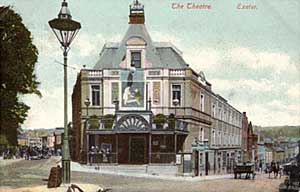 The Theatre Royal circa 1905.
The Theatre Royal circa 1905.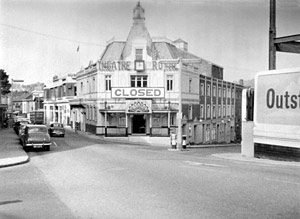 The last show has been performed before closure. Notice the partly
built Debenhams on the right. Photo courtesy Dick Passmore.
The last show has been performed before closure. Notice the partly
built Debenhams on the right. Photo courtesy Dick Passmore.
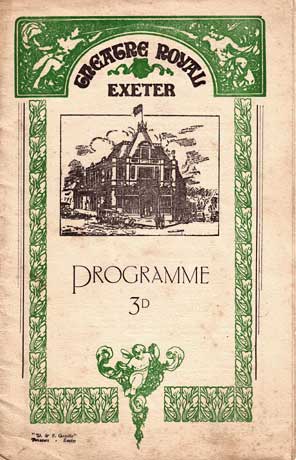
A programme from the 1920's.
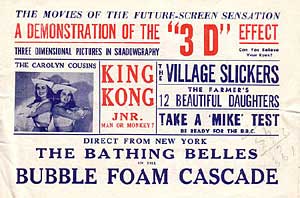 A flyer from 1954 for some
forthcoming attractions at the Theatre Royal.
A flyer from 1954 for some
forthcoming attractions at the Theatre Royal.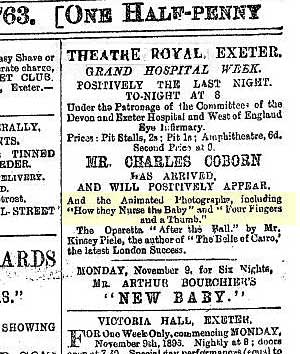 The advert from November 1896 for Exeter's Hospital Week.
The advert from November 1896 for Exeter's Hospital Week.
│ Top of Page │